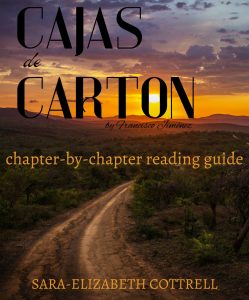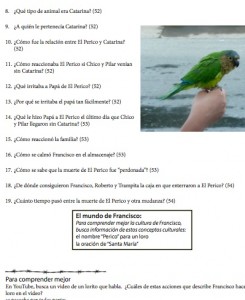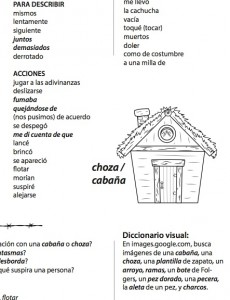Cajas de Cartón: an ebook reader’s guide
Purchase your guide:
Buy the guide and reproduce or distribute it as much as you like, for all of your students, for as long as you’re teaching, for only $29.95. You’ll need to purchase separately Spanish-language copies of the full memoir Cajas de cartón.
Keep reading or buy the complete reader’s guide with answer key now.
Get immediate access – buy it now for $29.95:
OR email a copy of your school’s purchase order to:
secottrell@musicuentos.com

Legal details:
Copyright 2014 Sara-Elizabeth Cottrell
Purchase includes the rights to reproduce or digitally distribute this digital file for the students of the purchasing teacher. Not transferable after use. Respect copyright law.
The memoir Cajas de cartón is copyright 1997 (Spanish translation copyright 2000) by Francisco Jiménez. All rights reserved.
NOTE: If you are only interested in the chapter guide for chapter 9, which is the short story also called Cajas de cartón, you’ll find information about purchasing that on my resources page.
Testimonials
For a great description of how Allison’s experience teaching this book changed between the plain question lists and the elegant ebook guide, see her posts Planning for Cajas de cartón and Literature Conversation Circles.
Sample
Check out the guide for Chapter 3.
About the novel
In Cajas de cartón, readers journey with Francisco Jiménez in his migrant journey. As a young boy, Francisco traveled with his family through Mexico north to the California border. His family crosses the border and he begins to experience the hardship and uncertainty of undocumented agricultural migrant life. Francisco’s family will grow, he will make friends, he moves more times than he can count, and through it all, the threat of being sent back to even more extreme poverty in Mexico always looms. Will Francisco be able to live the American dream his family believes can be theirs? What is the American dream, anyway?
Musicuentos Ebook Guides in Action
What are these ebook guides like? Check out Allison’s experience with teaching the memoir Cajas de cartón using my ebook guide in her posts Planning for Cajas de cartón and Literature Conversation Circles.
What are teachers saying about this bestseller?
Amazing and very flexible – well worth the price!
– DJ
Description
- Illustrated
- Professionally formatted
- 61 pages
- Detailed introduction
- Spanish/English glossary of all vocabulary words and phrases
Proficency- and vocabulary-boosting activities with every chapter:
Vocabulario
Each chapter’s section begins with a vocabulary list. Each lists emphasizes:
- how frequently the word appears
- application to advanced themes
- importance to the plot
- keys to advancing proficiency
Within the Vocabulary section, several activities get students using the words and phrases in memory-boosting ways. Translations of the words are not included so that you can determine how students interact with the meanings of the words. All words and phrases and their English translations are listed alphabetically in a dictionary at the end.
A repasar
After the first several chapters, each chapter includes a list of vocabulary words previously mentioned in a Vocabulario section. Sometimes these words are variations of previously used words.
Vocabulario
These questions enhance memory by causing students to relate vocabulary meaningfully to the world around them.
Relaciones
This section lists pairs or groups of words that are related somehow. Boost memory by asking students to make connections among vocabulary words. Are they all parts of the body? Things that you wear? Words related to injuries?
Diccionario Visual
Students remember more when a picture is attached to a word. Students are encouraged to look up several vocabulary words using Google Images. (Note: I have
looked up every word I recommend students to view, but still remind students to use discretion and turn on Safe Search.)
Dominio
Students perform a task specifically related to improving their proficiency, such as describing a scene, making a comparison, or narrating a story.
Conversación
Students have the opportunity to practice interpersonal conversation by talking with a classmate or friend about something related to the chapter and its vocabulary.
Imaginación con un modismo
Students practice idiomatic expressions, a key to developing advanced proficiency, in a way that uses their imagination, which increases memory.
Idioma
This section asks students to focus meaningfully on how particular words are formed or function in sentence.
Herramientas para el cuento
This new section offers specific advice on how students can improve their narration skills, important for students at the intermediate level.
Reflexión
This section was something I wished I’d included in the Ciudad guide. It suggests a journaling activity that will cause students to reflect on events in their own lives in order to help them preview the chapter’s main themes.
A leer
The second part of each “chapter” is a set of questions about the plot of the story, accompanied by proficiency-boosting activities.
Reading questions
These questions usually relate to major plot developments and often ask students to think critically about what they’re reading
Para ti
This activity asks students to relate something in Francisco’s story to their own world. Making cultural comparisons is an important skill in improving proficiency.
El mundo de Francisco
Students are asked to investigate cultural concepts Francisco mentions in the chapter, like La Llorona or los corridos mexicanos.
Investigación
This section suggests ways for students to take the perspective of immigrants by investigating a process, activity, or product mentioned in the chapter within their own community.
Para comprender más
Here I suggest comprehension-boosting activities such as making diagrams or character sketches or looking up pictures or videos of things or actions mentioned in the chapter.
Diccionario
The book ends with an 8-page glossary of every word or phrase included in the vocabulary lists.
OR email a copy of your school’s purchase order to:
secottrell@musicuentos.com
